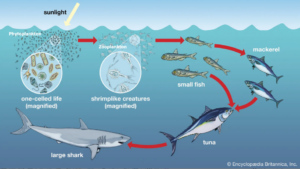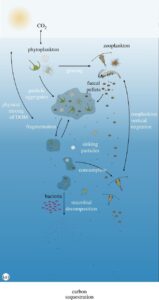Sunday, June 11, 2023 – Newport, Oregon
The Ocean is Life!

We gaze upon the ocean with solitude and awe, often during a beach stroll at sunrise or sunset, casting thoughts and reflections on our place in time. It behooves us to pause a moment and acknowledge the invisible ecosystem that drives our planet. Take a deep breath and be mindful that 50% of that breath was produced by the microbes of the sea.

The past two weeks aboard the R/V Sally Ride have provided opportunities to delve into this microscopic ecosystem that nourishes our planet; an ecosystem that is driven by ocean circulation and the transfer of energy and chemistry into algal life. Most aquatic food web diagrams include a reference to the phytoplankton contribution, typically isolated in a magnified bubble. (See Figure 50.) The PUPCYCLE II scientists immersed themselves inside that magnified bubble to investigate the responses of these single-celled organisms to changes in the ocean chemistry that sustains them; analyzing the autotrophs that combine light energy with chemical nutrients dissolved in the ocean and atmosphere to produce the food that supports life on Earth.
These primary producers have influenced our planet’s biogeochemical cycle through photosynthesis for millions of years. In addition to their contribution to our atmosphere and the aquatic food web, these microbes are also major contributors to the recycling and storage of carbon and silicon to the seafloor.3 Storing carbon, also know as carbon sequestration, assists in our planet’s homeostasis. (See Figure 51.)
So, continue to contemplate your life with a sunrise or sunset by the ocean but also be mindful and thankful to the researchers who devote their lives to learning more about our ocean’s chemistry and the microscopic ecosystem that supports and sustains our planet.
3 Benoiston, A.-S., F.M. Ibarbalz, L. Bittner, L. Guidi, O. Jahn, S. Dutkiewicz and C. Bowler (2017): The evolution of diatoms and their biogeochemical functions. Philosophical Transactions of the Royal Society B: Biological Sciences, 372: 20160397 (doi:10.1098/rstb.2016.0397) (http://doi.org/10.1098/rstb.2016.0397)
